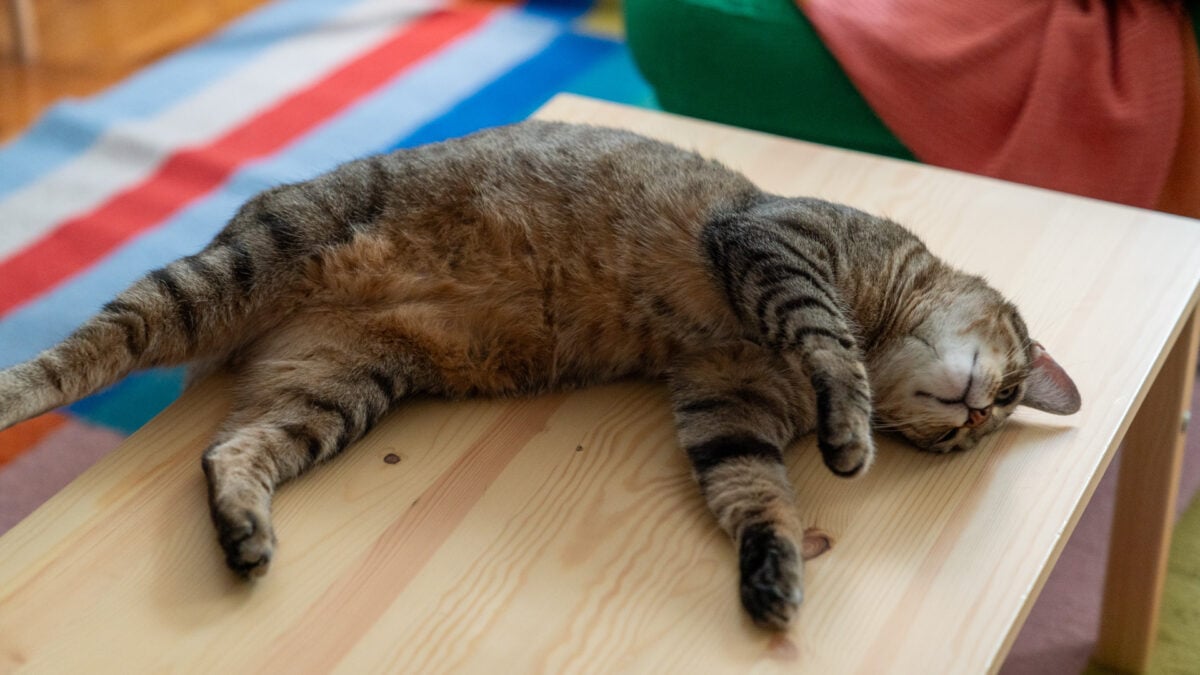Most Cats Sleep on Their Left Side, and Scientists Think They Know Why

If you’re a cat owner, chances are you spend an unhealthy amount of time scrolling through your photo gallery, reviewing adorable photos of your cats for the thousandth time. While doing so, perhaps you’ve noticed that your cats appear to favor a certain side while sleeping. And if that happens to be the left side, new scientific research suggests you’re right.
This could be a survival strategy for cats, according to a recent study published in Current Biology. In the paper, the researchers explain that in mammals such as cats, the right hemisphere of the brain controls the left visual field, spatial awareness, and quick responses to threats. Sleeping on the left allows the right hemisphere of a cat’s brain to be readily available to identify and coordinate a rapid escape, the scientists claim.
Virtually all animals are at risk to predators while sleeping. That’s a problem for cats (at least in their pre-domesticated natural state), who spend around 12 to 16 hours each day sleeping. For that reason, cats usually sleep in locations they consider safe. But the researchers were curious as to whether cats evolved other tactics to stay safe during and immediately after their frequent naps.
To answer this question, the researchers analyzed 408 publicly available YouTube videos featuring cats sleeping on their sides, with the requirement that the nap had to be uninterrupted for at least ten seconds. They found that in two-thirds of the videos, the cats preferred to sleep on their left side, which the researchers then attempted to explain in terms of neuroscience.
“Since cats prefer to sleep in elevated positions, upon awakening they would immediately see predators or prey with the left side of their visual field,” the study authors explained in a statement. “Since the right hemisphere has advanced spatial abilities and can quickly coordinate rapid escape and possibly also hunting functions, left-side sleeping would provide evolutionary benefits as a survival strategy.”
But as the scientists themselves admit, this conclusion warrants further investigation to explore other potential factors that influence a cat’s favored sleeping position. While their analysis of the videos turned up a statistically significant leftward bias at the population level, “we obviously have no information about the sex or pregnancy status of the videotaped cats,” they wrote in the paper.
Indeed, pregnancy might be another complicating variable, a trend scientists previously observed for pregnant cows. Additionally, “pawedness”—the cat version of right- or left-handedness—should also be taken into consideration for future research, the scientists said.
Overall, the authors conclude that this finding, while subject to debate, “could provide an excellent opportunity to study the emergence of asymmetries at the population level, while also helping us to learn more about the nature of one of our favorite pets.”
A quick and very unscientific population survey among Gizmodo and Kotaku’s cat owners affirmed the study’s findings, showing a slightly greater tendency for cats to favor their left side while sleeping. I was also able to confirm that my roommate’s two cats both tend to curl up on their left side. There were, however, some outlier cases, such as Kotaku staff writer Zachary Zwiezen’s feline companion, who reportedly “just does the super tight curl and turns into a strange organic shape that, while cute, lacks any sides.”
To gather more data, we’d like to invite our readers to share their cats’ favored sleeping position in the comments. Photo evidence is encouraged.









